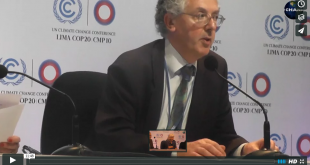NASA’s Dr Ali Omar (Research scientist – Chemistry and Dynamics div. of Langley Research Centre) speaks on NASA Earth Observations Systems and Applications, from which data is utilized for societal benefit to solve day to day issues in terms of Health and Air Quality, globally, at COP 22, Marrakech.
NASA currently has multiple Earth Science missions in operation, with various new missions covering oceans, land, atmosphere, water and air quality being added within last 5-10 years, which are globally recording and making environmental measurements of the state of the climate 24/7, whilst orbiting Earth. There is a broad base of corroboration between NASA and other US agencies, e.g. (2013) LANDSAT 8 (USGS) including others being collaborative with international partners, i.e. (2008) OSTM/Jason 2 with Japan and (2006) Calipso with France, etc. with the OCO2 Orbital Carbon Observatory being a prime example of several countries partnering with US to achieve the international A-train (A-train : a system of instruments that fly within approximately 10 minutes of each other, observing the same location on Earth, so as to get synergistic measurements which provide an unprecedented sensor system for Earth observations).
In terms of Health and Air Quality, focus in this area is ostensibly discovering and demonstrating innovative and practical uses of Earth’s observations in organizations policy, business and management decisions, working with academia, private organizations, NGO’s including others looking to apply the data to produce a solution that is beneficial to society. The Applied Sciences program has four main areas of focus, namely – Health and Air Quality, Water Resources, Disasters and Ecological forecasting with a capacity building organization called ‘SERVIR’ which has several hubs around the globe, i.e. East and West Africa, South Africa, South America and Asia – this platform uses NASA’s observations and predictive models for their environmental management, disaster responsibility and climate change adaptation, which also includes an intense program of training and capacity building to groups in order to facilitate their understanding and usage of the supplied scientific data, at ground level.
Climate change has a very causative impact on health and air quality in terms of changing weather patterns, which leads to different contamination pathways for disease, air pollution levels and transmission dynamics, which in turn leads to health effects like heat-related illness and death, air pollution related health effects, etc. including vector and rodent borne diseases which are very sensitive to environmental conditions.
NASA’s objectives in terms of their Health and Air Quality Application Area cover inter alia; a) supports use of Earth observations in our quality management and public health regarding infectious diseases and environment health issues, b) promotes use of Earth observation data and models regarding the implementation of air quality standards, policy and regulations for economic and human welfare, c) addresses issues of toxic and pathogenic exposure and health related hazards and their effects for risk characterization and mitigation, d) addresses the effects of climate change on public health and air quality to support managers and policy makers in their planning and preparations to manage climate change globally.
Links :
https://science.nasa.gov/earth-science/applied-sciences
https://www.servirglobal.net/
https://www.nasa.gov/press/2015/february/nasa-briefing-to-highlight-early-results-from-new-earth-science-missions
 Mother Channel Environmental, climate change news and media.
Mother Channel Environmental, climate change news and media.



